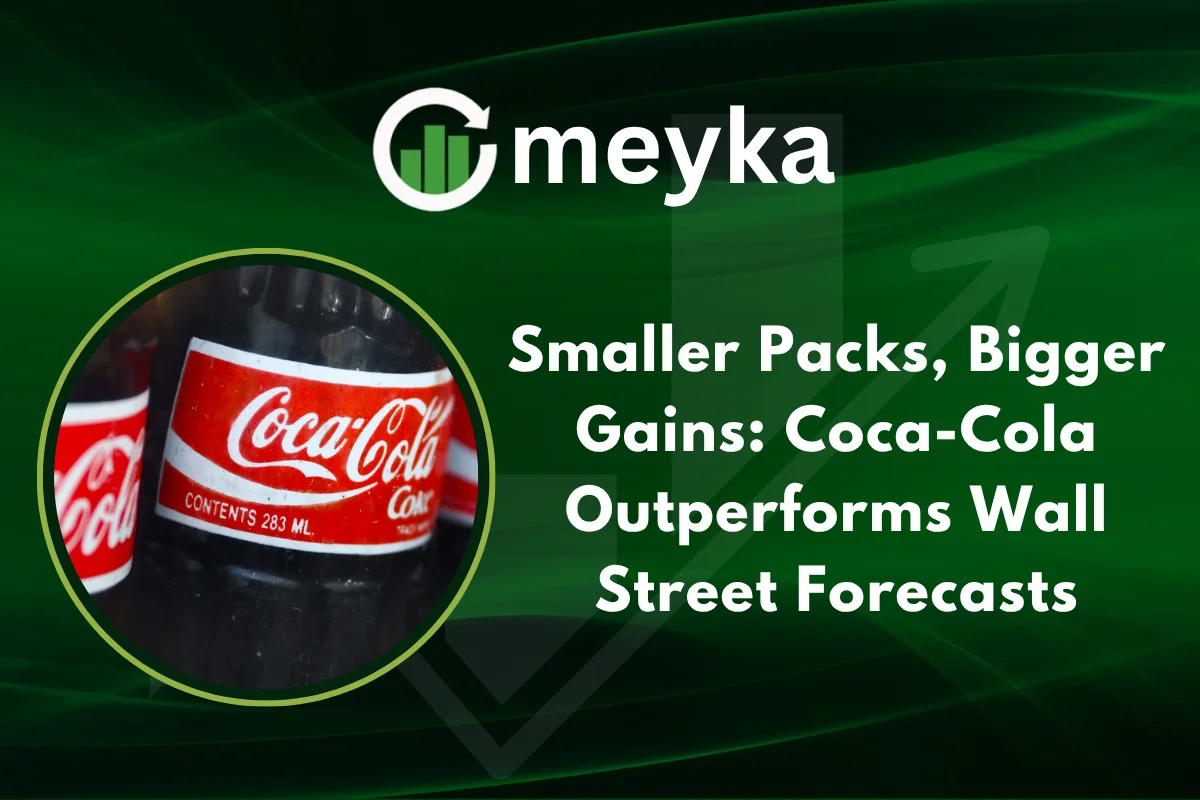Smaller Packs, Bigger Gains: Coca-Cola Outperforms Wall Street Forecasts
At a time when many consumer brands are wrestling with rising costs, shifting consumer habits, and soft volume growth, The Coca‑Cola Company (KO) is proving that smart packaging, pricing discipline, and a diverse product portfolio can give it an edge.
Coca-Cola’s recent results: beating the forecasts
Coca-Cola’s latest quarter demonstrated the company’s resilience. Revenue rose to about $12.46 billion, topping consensus estimates. Adjusted earnings-per-share (EPS) came in at approximately $0.82, beating analyst expectations of about $0.78. While volume growth was modest (roughly 1 % year-over-year), pricing and product mix lifted the performance.
For investors performing stock research, this is important: it’s not always about lofty volume growth but margin enhancement and smart product strategies.
The “smaller packs” advantage
One of the key strategic moves for Coca-Cola has been to shift part of its focus toward smaller package sizes. This is part of its revenue-growth management (RGM) and portfolio mix strategy.
Smaller packs generate a higher price per unit (e.g., per ounce), often allow the company to offer more affordable entry pricing for consumers, and thereby drive incremental transactions. For example, back in 2015, Coca-Cola noted that smaller packs in North America were growing much faster than larger packs, in the high teens growth area.
More recently, the company emphasised smaller packs and the shift in pack sizes across geographies, as part of its growth engine.
This strategy enables Coca-Cola to capture value even as some consumers trade down or seek more affordable treats. It also helps manage margin pressures by heavy reliance on pricing, product mix improvement, and packaging innovation.
Why this matters to the stock market and investors
For those of us doing stock research or evaluating stocks alongside AI stocks and other high-growth plays, Coca-Cola offers a somewhat different profile: a large consumer staples business with enduring brand power, but also fresh strategic levers.
- Steady growth in a challenging environment: In a consumer landscape with inflation and shifting behaviour, Coca-Cola’s ability to generate organic growth of ~5% in many markets is notable.
- Margin and mix improvements over pure volume growth: While volume growth is modest, the pricing per case, pack-mix shift toward smaller packs, entry-price versions, and premium variants (zero sugar, adult sparkling) add margin.
- Diversification vs. pure high-growth risk: Unlike many of the AI stocks that carry high growth but high risk, Coca-Cola offers more stability and may appeal to those balancing portfolios.
- Global footprint and local execution: As noted in the company’s growth strategy, the brand is focusing on “Marketing, Innovation, Revenue Growth Management (RGM) and Integrated Execution”. This is important in global stock market terms because emerging markets often offer higher growth potential.
Linking packaging changes to broader business strategy
Coca-Cola’s shift to smaller packs is not just about size, it’s a manifestation of its strategic growth framework. The “top-line flywheel” concept includes marketing tailored to local needs, innovation in packages and products, revenue-growth management (identifying pools and how to win), and integrated execution.
Smaller packs deliver on several nodes:
- Innovation: New pack formats draw consumer interest and give a reason to purchase.
- Revenue Growth Management (RGM): Identifying entry packs, premium packs, and managing pricing per unit is key.
- Marketing: With smaller, more accessible pack sizes, the brand can recruit new users or capture additional occasions.
- Integrated Execution: Ensuring availability, cold-drink equipment, shelf presence, and pricing work together globally.
Emerging markets and geographic opportunities
While developed markets offer slower growth, emerging markets are a significant part of Coca-Cola’s growth engine. According to a recent update from its bottling partner Coca‑Cola HBC AG, organic revenue in emerging markets rose 7.9 % in the latest quarter, with volume growth of 2.0%.
This geographic diversification means the company is not solely reliant on mature markets and can benefit from global consumption growth, making it relevant in stock research as a core consumer stock.
What this means for investors now
Given its performance and strategic moves, here are key takeaways for investors:
- The stock of Coca-Cola could serve as a core holding, especially for those seeking stability with moderate growth.
- Its smaller-pack strategy suggests that the company is taking tactical steps to drive volume and transaction growth, not just relying on raising prices.
- Analysts are watching for execution in product innovation and pack formats, as well as global expansion. For instance, upcoming launches of mini-cans and entry packs will be meaningful.
- When comparing against high-growth sectors like AI stocks, Coca-Cola stands out as a more defensive, value-oriented component of a diversified portfolio.
- That said, growth is not explosive, so if an investor’s objective is aggressive growth (as in many AI stock stories), this may not match that profile, but if the goal is steady returns with brand strength, Coca-Cola is very compelling.
Risk factors to consider
No investment is without risk. With Coca-Cola:
- Volume growth remains modest (around 1 % in recent quarters). If pack size shifts don’t compensate for volume softness, the upside may be limited.
- Input cost inflation, currency headwinds, and macroeconomic pressures remain concerns for global consumer businesses.
- The smaller pack strategy must maintain disciplined pricing/per-unit economics; if consumers perceive the smaller packs as gimmicks or sacrifice value, the strategy might falter.
- Competitive pressure and health-conscious consumer trends mean continuous innovation is required.
Conclusion
Coca-Cola is demonstrating that by focusing on smarter packaging (smaller packs), disciplined pricing, and mix leverage, a legacy brand can still outperform and deliver value. For those conducting stock research and comparing consumer staples to growth-oriented AI stocks or broader stock market plays, Coca-Cola stands out as a well-executed business with both global reach and innovative tactics.
The smaller pack story is not just packaging; it’s an indicator of strategic intent and execution discipline. For investors looking to diversify beyond high-growth, high-volatility stocks, this company may well deserve a place in the portfolio.
FAQs
Smaller packs help because they often carry a higher price per unit volume, appeal to consumers looking for affordable “treat” sizes, and drive more transaction occasions. According to older data, Coca-Cola’s smaller pack sizes in North America grew at double-digit rates and delivered higher margins.
While many AI stocks target rapid growth and high risk, Coca-Cola offers a stable, brand-driven, global business with lower growth but reliable earnings. It can complement a portfolio heavy in growth stocks by offering ballast. Furthermore, its approach of packaging innovation and revenue-growth management reflects strategic execution rather than just growth optimism.
Watch for continued growth in emerging markets, new pack formats (especially smaller entry sizes), how pricing per unit evolves, and how well the company manages cost inflation and currency impacts. Also monitor the company’s innovation pipeline, such as new variants and premiumisation in the beverage category.
Disclaimer:
This content is made for learning only. It is not meant to give financial advice. Always check the facts yourself. Financial decisions need detailed research.






